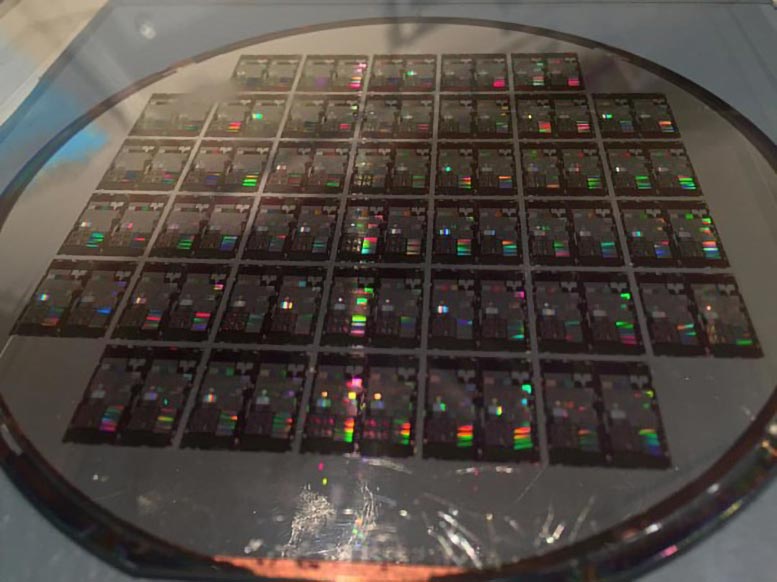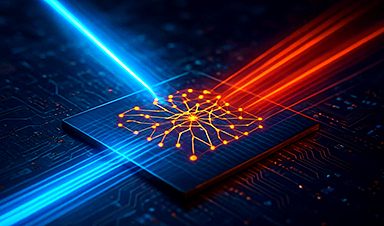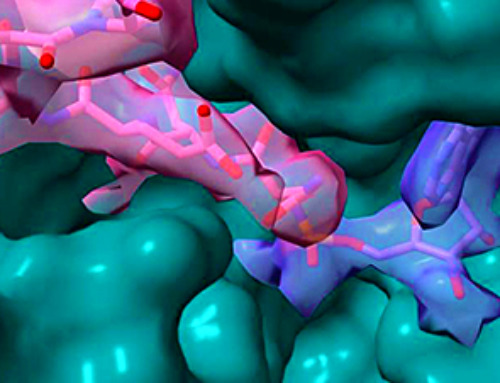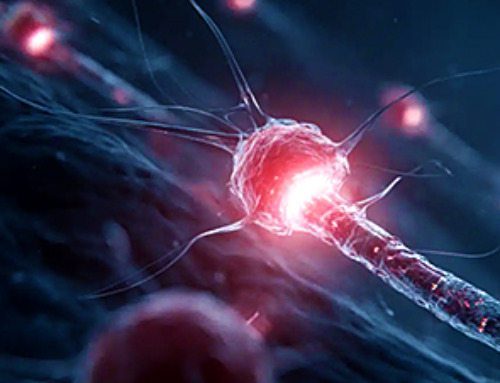A cutting-edge AI acceleration platform powered by light rather than electricity could revolutionize how AI is trained and deployed.
Using photonic integrated circuits made from advanced III-V semiconductors, researchers have developed a system that vastly outperforms traditional silicon GPUs in both energy efficiency and speed. This technology could not only lower energy costs but also scale AI to new levels of performance, potentially transforming everything from data centers to future smart systems.
The AI Boom and Its Infrastructure Challenges
Artificial intelligence (AI) is rapidly transforming a wide range of industries. Powered by deep learning and vast datasets, AI systems require enormous computing power to train and operate. Today, most of this work relies on graphical processing units (GPUs), but their high energy consumption and limited scalability pose significant challenges. To support future growth in AI, more efficient and sustainable hardware solutions are needed.
A Leap Forward: Photonic Circuits for AI
A recent study published in the IEEE Journal of Selected Topics in Quantum Electronics introduces a promising alternative: an AI acceleration platform built on photonic integrated circuits (PICs). These optical chips offer better scalability and energy efficiency than traditional, GPU-based systems. Led by Dr. Bassem Tossoun, Senior Research Scientist at Hewlett Packard Labs, the research shows how PICs that incorporate III-V compound semiconductors can run AI workloads faster and with far less energy.
Unlike conventional hardware, which uses electronic distributed neural networks (DNNs), this new approach uses optical neural networks (ONNs), circuits that compute with light instead of electricity. Because they operate at the speed of light and minimize energy loss, ONNs hold great potential for accelerating AI more efficiently.

“While silicon photonics are easy to manufacture, they are difficult to scale for complex integrated circuits. Our device platform can be used as the building blocks for photonic accelerators with far greater energy efficiency and scalability than the current state-of-the-art,” explains Dr. Tossoun.
The team used a heterogeneous integration approach to fabricate the hardware. This included the use of silicon photonics along with III-V compound semiconductors that functionally integrate lasers and optical amplifiers to reduce optical losses and improve scalability. III-V semiconductors facilitate the creation of PICs with greater density and complexity. PICs utilizing these semiconductors can run all operations required for supporting neural networks, making them prime candidates for next-generation AI accelerator hardware.
How the Platform Was Fabricated
The fabrication started with silicon-on-insulator (SOI) wafers that have a 400 nm-thick silicon layer. Lithography and dry etching were followed by doping for metal oxide semiconductor capacitor (MOSCAP) devices and avalanche photodiodes (APDs). Next, selective growth of silicon and germanium was performed to form absorption, charge, and multiplication layers of the APD. III-V compound semiconductors (such as InP or GaAs) were then integrated onto the silicon platform using die-to-wafer bonding. A thin gate oxide layer (Al₂O₃ or HfO₂) was added to improve device efficiency, and finally a thick dielectric layer was deposited for encapsulation and thermal stability.
A New Frontier in AI Hardware
“The heterogeneous III/V-on-SOI platform provides all essential components required to develop photonic and optoelectronic computing architectures for AI/ML acceleration. This is particularly relevant for analog ML photonic accelerators, which use continuous analog values for data representation,” Dr. Tossoun notes.
This unique photonic platform can achieve wafer-scale integration of all of the various devices required to build an optical neural network on one single photonic chip, including active devices such as on-chip lasers and amplifiers, high-speed photodetectors, energy-efficient modulators, and non-volatile phase shifters. This enables the development of TONN-based accelerators with a footprint-energy efficiency that is 2.9 × 10² times greater than other photonic platforms and 1.4 × 10² times greater than the most advanced digital electronics.
Transforming AI with Light-Speed Efficiency
This is indeed a breakthrough technology for AI/ML acceleration, reducing energy costs, improving computational efficiency, and enabling future AI-driven applications in various fields. Going forward, this technology will enable datacenters to accommodate more AI workloads and help solve several optimization problems.
The platform will be addressing computational and energy challenges, paving the way for robust and sustainable AI accelerator hardware in the future!
Reference: “Large-Scale Integrated Photonic Device Platform for Energy-Efficient AI/ML Accelerators” by Bassem Tossoun, Xian Xiao, Stanley Cheung, Yuan Yuan, Yiwei Peng, Sudharsanan Srinivasan, George Giamougiannis, Zhihong Huang, Prerana Singaraju, Yanir London, Matěj Hejda, Sri Priya Sundararajan, Yingtao Hu, Zheng Gong, Jongseo Baek, Antoine Descos, Morten Kapusta, Fabian Böhm, Thomas Van Vaerenbergh, Marco Fiorentino, Geza Kurczveil, Di Liang and Raymond G. Beausoleil, 9 January 2025, IEEE Journal of Selected Topics in Quantum Electronics.
DOI: 10.1109/JSTQE.2025.3527904
News
Team finds flawed data in recent study relevant to coronavirus antiviral development
The COVID pandemic illustrated how urgently we need antiviral medications capable of treating coronavirus infections. To aid this effort, researchers quickly homed in on part of SARS-CoV-2's molecular structure known as the NiRAN domain—an [...]
Drug-Coated Neural Implants Reduce Immune Rejection
Summary: A new study shows that coating neural prosthetic implants with the anti-inflammatory drug dexamethasone helps reduce the body’s immune response and scar tissue formation. This strategy enhances the long-term performance and stability of electrodes [...]
Scientists discover cancer-fighting bacteria that ‘soak up’ forever chemicals in the body
A family of healthy bacteria may help 'soak up' toxic forever chemicals in the body, warding off their cancerous effects. Forever chemicals, also known as PFAS (per- and polyfluoroalkyl substances), are toxic chemicals that [...]
Johns Hopkins Researchers Uncover a New Way To Kill Cancer Cells
A new study reveals that blocking ribosomal RNA production rewires cancer cell behavior and could help treat genetically unstable tumors. Researchers at the Johns Hopkins Kimmel Cancer Center and the Department of Radiation Oncology and Molecular [...]
AI matches doctors in mapping lung tumors for radiation therapy
In radiation therapy, precision can save lives. Oncologists must carefully map the size and location of a tumor before delivering high-dose radiation to destroy cancer cells while sparing healthy tissue. But this process, called [...]
Scientists Finally “See” Key Protein That Controls Inflammation
Researchers used advanced microscopy to uncover important protein structures. For the first time, two important protein structures in the human body are being visualized, thanks in part to cutting-edge technology at the University of [...]
AI tool detects 9 types of dementia from a single brain scan
Mayo Clinic researchers have developed a new artificial intelligence (AI) tool that helps clinicians identify brain activity patterns linked to nine types of dementia, including Alzheimer's disease, using a single, widely available scan—a transformative [...]
Is plastic packaging putting more than just food on your plate?
New research reveals that common food packaging and utensils can shed microscopic plastics into our food, prompting urgent calls for stricter testing and updated regulations to protect public health. Beyond microplastics: The analysis intentionally [...]
Aging Spreads Through the Bloodstream
Summary: New research reveals that aging isn’t just a local cellular process—it can spread throughout the body via the bloodstream. A redox-sensitive protein called ReHMGB1, secreted by senescent cells, was found to trigger aging features [...]
AI and nanomedicine find rare biomarkers for prostrate cancer and atherosclerosis
Imagine a stadium packed with 75,000 fans, all wearing green and white jerseys—except one person in a solid green shirt. Finding that person would be tough. That's how hard it is for scientists to [...]
Are Pesticides Breeding the Next Pandemic? Experts Warn of Fungal Superbugs
Fungicides used in agriculture have been linked to an increase in resistance to antifungal drugs in both humans and animals. Fungal infections are on the rise, and two UC Davis infectious disease experts, Dr. George Thompson [...]
Scientists Crack the 500-Million-Year-Old Code That Controls Your Immune System
A collaborative team from Penn Medicine and Penn Engineering has uncovered the mathematical principles behind a 500-million-year-old protein network that determines whether foreign materials are recognized as friend or foe. How does your body [...]
Team discovers how tiny parts of cells stay organized, new insights for blocking cancer growth
A team of international researchers led by scientists at City of Hope provides the most thorough account yet of an elusive target for cancer treatment. Published in Science Advances, the study suggests a complex signaling [...]
Nanomaterials in Ophthalmology: A Review
Eye diseases are becoming more common. In 2020, over 250 million people had mild vision problems, and 295 million experienced moderate to severe ocular conditions. In response, researchers are turning to nanotechnology and nanomaterials—tools that are transforming [...]
Natural Plant Extract Removes up to 90% of Microplastics From Water
Researchers found that natural polymers derived from okra and fenugreek are highly effective at removing microplastics from water. The same sticky substances that make okra slimy and give fenugreek its gel-like texture could help [...]
Instant coffee may damage your eyes, genetic study finds
A new genetic study shows that just one extra cup of instant coffee a day could significantly increase your risk of developing dry AMD, shedding fresh light on how our daily beverage choices may [...]





















